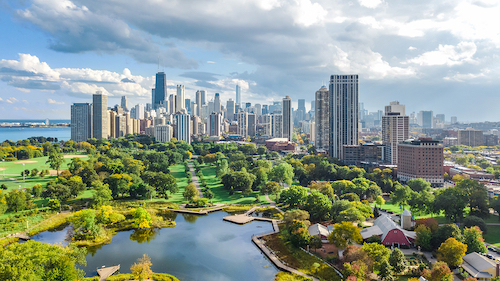 The problem? A bad mood. The solution? A walk in the park, literally.
The problem? A bad mood. The solution? A walk in the park, literally.
A study by researchers at the University of Vermont found that those living in urban areas who visited parks were more positive, used happier words and expressed less negativity on Twitter.
They found that not only did the happy impact from parks lead to a better mood for up to four hours after a park visit, it also had an equivalent mood spike in happiness similar to Christmas, which is considered the happiest day of the year on Twitter.
“We found that people use happier words when visiting parks, that they continue to do so for several hours following the visit, and that the tweets in greener and larger parks showed the greatest boost in mood,” Aaron Schwartz, a UVM graduate student who led the research, told Theravive.
To undertake their study, the researchers studied hundreds of tweets per day over a period of three months. They focused on tweets that people had made from parks and found that on the whole, people seemed happier. That effect was found to be the strongest in large parks with lots of trees and vegetation. Other outdoor spaces like paved civic plazas showed the least amount of mood elevation while small parks in neighbourhoods showed a small spike in mood.
The researchers argue that particularly in cities, green spaces are essential for personal wellbeing, with more and more research suggesting that access to green spaces like parks aids mental health.
To determine the extent of happiness displayed in tweets, the team at UVM used a tool called the hedonometer. The instrument was designed by UVM scientists and has been collecting and analyzing billions of tweets for over a decade. In establishing the instrument, volunteers gave a pool of around 10 thousand common words a score for its psychological valence, which is a form of measure for the emotional temperature of each word. Happy words ranked highly on a scale of one to nine, whilst sad words ranked lower.
Using scores from the hedonometer, the researchers collected roughly fifty million tweets daily, and calculate the average happiness score.
From there, the researchers selected tweets from just under 5000 users who publicly identified their location in their tweet through geotagging. This enabled researchers to determine which tweets were coming from park and which weren’t. With assistance from the US Forest Service, they mapped the vegetation of urban areas in San Francisco to get a sense of the greenness and vegetation of a space.
They found that the greener the park, the greater the boost in mood.
Tweets that were posted from parks were found to be 0.23 points happier than the baseline scale on the hedonometer. This is equivalent to the boost in mood found on Twitter on Christmas Day.
The researchers note that being in nature, particularly for people living in urban cities, provides a restorative benefit that cannot be matched through a purchase or on a phone screen.
They say their study could have ramifications for urban planning, given the amount of people living in cities, as well as a rising rate of mood disorders among the general population.
“We think our findings support the idea that all urban residents should have access to high quality parks, especially larger and greener spaces,” Schwartz told Theravive.
Although the study did not set out to determine why parks and green spaces may result in a boost in mood, the researchers say there could be several reasons why nature appears to boost mental health. One such idea is the Green Mind Theory, which suggests the brain, mind and body is impacted by the environment. By going to parks, a person can give their brain and mind a break from a society that is constantly presenting stressors.
The researchers found negative language like ‘can’t’, ‘don’t’ and ‘no’ decreased in the period immediately following a visit to the park.
“There are a growing number of people living in cities and rising rates of poor mental health. This study contributes to a growing body of literature showing that nature contributes to a variety of dimensions of human well-being,” Schwartz said.
The researchers hope to expand the research to examine greenspace other than parks, like trees on the street.
They say their research is a reminder that preserving urban greenspace is essential, and should be taken seriously by town planners and policy makers alike.
So next time you’re in a bad mood, just head towards a green space. It’s as easy as a walk in the park.
Elizabeth Pratt is a medical journalist and producer. Her work has appeared on Healthline, The Huffington Post, Fox News, The Australian Broadcasting Corporation, The Sydney Morning Herald, News.com.au, Escape, The Cusp and Skyscanner. You can read more of her articles here. Or learn more about Elizabeth and contact her via her LinkedIn and Twitter profiles.